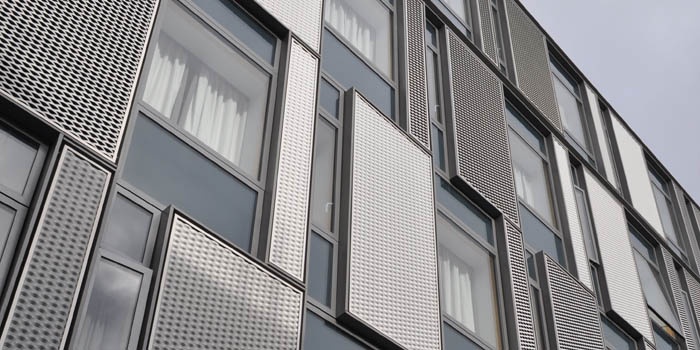
VELFAC composite windows and doors are a distinctive element within the different facades used in the multi-storey accommodation blocks, also delivering essential low-energy, low-maintenance performance.
The glazing was specified by Tryfon Kalyvides, of The Kalyvides Partnership, who had used VELFAC before and knew what the window system could deliver. ‘At Deaconess House, as for many of our projects, we wanted to achieve fine and sophisticated detailing with windows forming an important part of the overall composition,’ explains Tryfon. ‘The VELFAC system is unique in that every window has a slender frame and uniform sightlines, so that opening lights are rarely distinguishable from fixed. This increases the uniformity of the facade and adds to the quality of the design.’
Architecturally complex
Deaconess House is a complex development, architecturally and structurally, and Tryfon worked closely with the VELFAC team in order to achieve a very specific result. Facing the street, VELFAC is used as punch-hole windows and to create an upper storey glazed facade, while the inner courtyard features a dramatic ‘shifted geometric’ design. ‘We used VELFAC glazing within a natural stone cladding system to deliver a sharp, mature exterior,’ comments Tryfon, ‘and at the upper levels, where a lighter aesthetic was demanded, we installed VELFAC units within glazed spandrel panels to give the effect of curtain walling but at a scale appropriate to the neighbouring refurbished hospital building.’ To achieve the ‘more abstract’ courtyard facades, VELFAC windows and doors were installed within a perforated mesh panel system. ‘Across the building the uniform VELFAC sightlines are used to bring together the external and courtyard facades, providing a visual link which also helps unify the development. Achieving this unity depended on the successful installation of the VELFAC system within these different interfaces, and both the VELFAC technical team and the company’s installers provided the excellent support we needed to achieve our goal.’
Low energy performance and impressive acoustic insulation
As well as architectural versatility, VELFAC was also specified for its low-energy performance and impressive acoustic insulation, and for the durable, low maintenance frame design. Externally, aluminium framing is finished in deep grey, complementing the grey stone used in the build, while the clear lacquered inner pine frame is used to add warmth and colour to student rooms and shared spaces. ‘Timber is a ‘user-friendly’ material’, comments Tryfon. ‘If we are working on a project with timber floors we often paint the inner VELFAC frame to avoid a ‘clash’ of interior finishes, but this was not the case at Deaconess House and meant we could retain the wood finish to deliver a degree of quality.’
The Deaconess House project has proved highly successful, and is now occupied by University students. ‘The system is clearly value for money,’ says Tryfon, ‘and it is continuously being tested and improved to meet the performance requirements demanded of standards such as BREEAM and the Code for Sustainable Homes. I have specified VELFAC for most of my independent career and I always encourage my clients to consider the VELFAC system.’